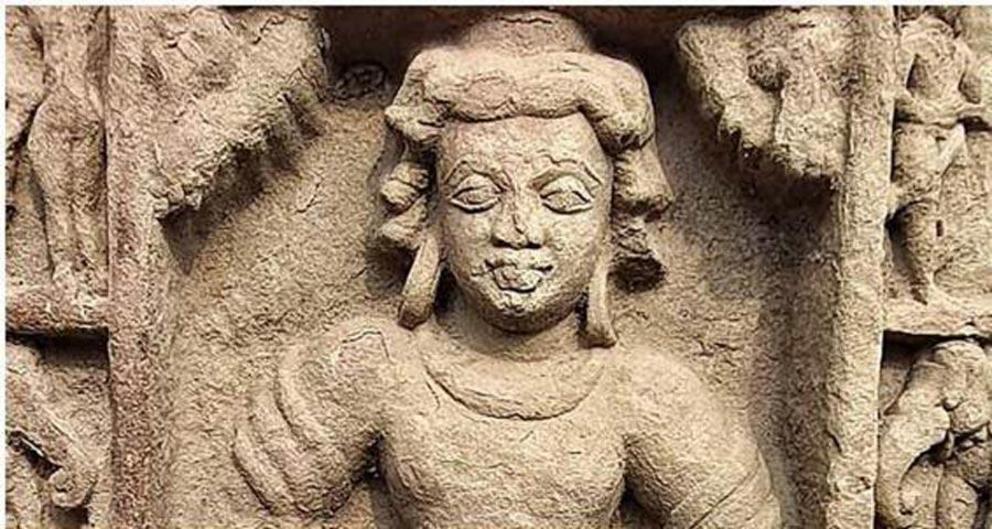1,500-year-old temple ruins discovered in Uttar Pradesh, India
Top image: Ancient temple remains found at Bilsarh village.
Uttar Pradesh, India’s most populous state, and one of its largest, is located in the northern Gangetic plains of the country. With a storied history and a slew of rulers having fought over parts of its territory since ancient times, it is no surprise that a 1,500-year-old temple, from the glory days of the ‘Gupta period’ has been discovered by the prestigious Archaeological Survey of India . Dated to the 5th century AD, this discovery of ancient stairs leading to a temple, has been made in Bilsarh locality in UP’s Etah, reports Times of India .
Undeciphered Script
Part of the ASI’s ‘routine scrubbing’, the remains of this temple revealed a staircase with Shankhalipi inscriptions that revealed Sri Mahendraditya’s name, a title adopted by the Gupta ruler Kumaragupta I, who would rule over this part of northern-central India for almost 40 years. Overgrowth scrubbing is a huge menace to monuments after every Indian monsoon, owing to the rapid grass and tree spread during and immediately after this season, which lasts from June-August in India.
Shankhalipi refers to the shell-script, a term used by scholars to describe undeciphered ornate spiral characters, that are presumed to be derivatives of the Brahmi language and are dated to between the 4th and 8th centuries. It’s been found on rock shelters in Madhya Pradesh, Bengal, and Karnataka in painted forms, along with temple pillars, standing columns, and rock surfaces. No more than 10 to 12 syllables exist, and generally is used to represent names, auspicious symbols, or both.
“There were two decorative pillars at the spot close to one another, with human figurines found earlier. To understand their significance, we conducted further excavation and found the stairs. We found something written on it in Shankhalipi. It was deciphered as saying ‘Sri Mahendraditya’ which was the title of Kumaragupta I of the Gupta dynasty,” says Vasant Swarnkar, superintending archaeologist of ASI’s Agra circle.
The Guptas: India’s Ancient Glory?
The Guptas were an ancient empire from the early 4th century AD to late 6th century AD, and its zenith, covered much of the Indian subcontinent. This period is renowned for great socio-cultural developments, including the canonising of classical texts like the Mahabharata and the Ramayana, along with the Puranas, and some of the most influential academic scholars of the Indian subcontinent like Kalidasa, Aryabhata, and Vatsyayana. Theirs was the last unifying kingdom for a long time in Indian history, as after this, a lot of regional kingdoms emerged and assumed power.
“The Guptas were the first to build structural temples for Brahminical, Buddhist, and Jain followers. Prior to that, only rock-cut temples were built. Before this, only two structural temples were found – Dashavatara Temple in Deogarh and Bhitargaon Temple in Kanpur Dehat. The Etah pillars are well-sculpted, better than earlier examples in which only the lower sections were carved. The decorative pillars and staircase are a bit more advanced than the earlier ones,” says Professor Manvendra Pundhir from the history department of the Aligarh Muslim University.
Lakhimpur Kheri was where the writing was discovered previously on a horse statue found on two skeletons in Etah, now on display in Lucknow’s famed State Museum. Swarnkar, however, did not feel completely convinced and forwarded the photographs of the inscriptions to Dr. Devendra Handa, a renowned epigraphist, who confirmed that this was from Kumaragupta I’s reign. Kumaragupta I is rumoured to have founded the famed ancient city of Nalanda.
Gupta Period Architecture
The Gupta period architecture is very diverse in style, design and features, indicating that it was in its formative stage, and was yet to achieve the standardisation of later centuries. The Gupta style was influenced by Kusana, Mathura, and Gandhara and borrowed the common features of T-shaped doorways, decorated door jambs, sculpted panels with high-relief figures, and laurel-wreath and acanthus motifs. Constructed using sandstone, granite, and brick, Gupta-era temples added to this architectural heritage with horseshoe gavakshas arches and distinctive curved shikhara towers which are frequently topped with a ribbed disk ornamentation known as an amalaka.
The Etah ruins are just the third Gupta era structure temple discovered so far. For Brahminical, Buddhist, and Jain followers, the Guptas were the first to construct structural temples. Prior to then, only rock-cut temples had been constructed. Professor Manvendra Pundhir of the history department at Aligarh Muslim University agreed. "Only two structural temples have been discovered before this: Dashavatara Temple in Deogarh and Bhitargaon Temple in Kanpur Dehat. The Etah pillars are well-sculpted, far superior to earlier versions that were simply carved in the lowest portions. The ornate pillars and staircase are a step forward from the previous ones.”
For the rest of this article please go to source link below.

